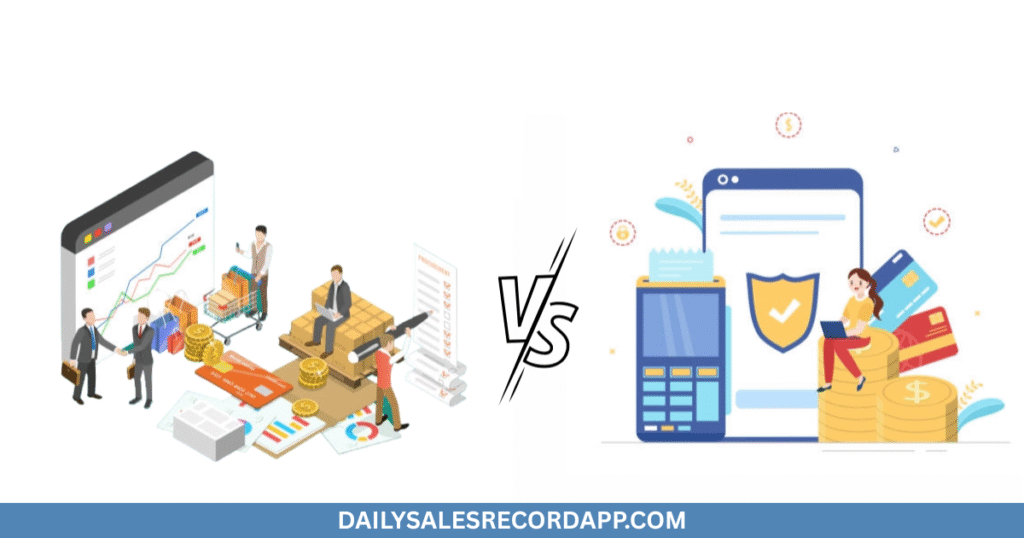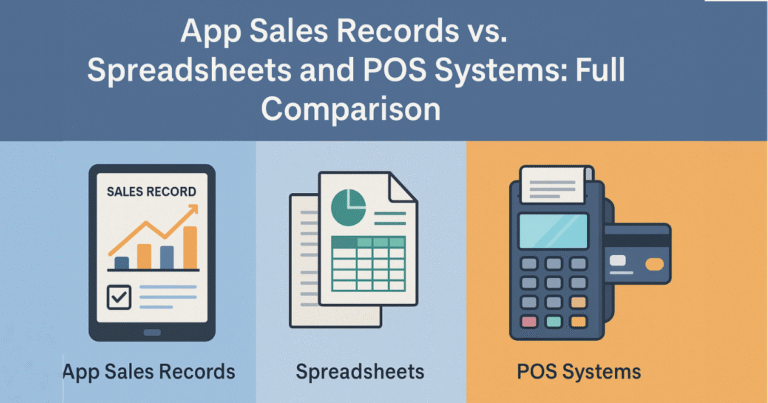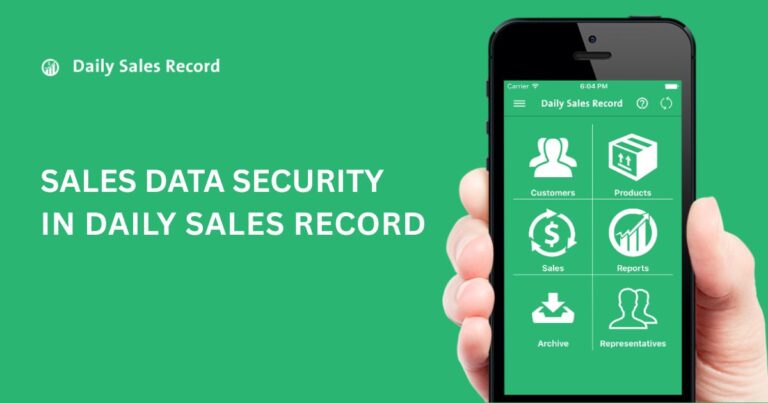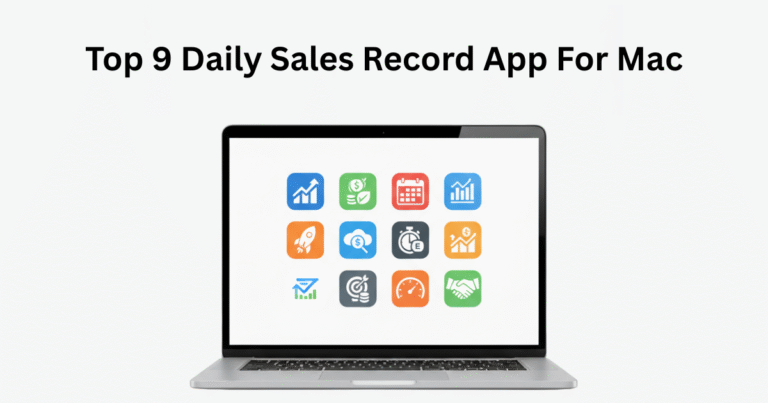Digital Sales Tracking vs. Manual Record Keeping
When it comes to Digital Sales Tracking vs. Manual Record Keeping, the difference is clear. Manual record keeping involves writing down sales by hand. It can lead to mistakes and take up a lot of time. As your business grows, managing paper records or spreadsheets becomes more challenging. On the other hand, digital sales tracking automates this process, allowing you to track sales in real time, generate reports instantly, and reduce the risk of errors.
Switching to digital sales tracking is easy and doesn’t require advanced technical skills. Tools like the Daily Sales Record App help you stay organised, save time, and access your data from anywhere. Moving away from manual methods means fewer headaches and more time to focus on growing your business. Make the transition today and experience the benefits of digital sales tracking over manual record-keeping.
Getting to Know Sales Tracking Systems
Sales tracking helps you keep tabs on your business. It tells you what you’re selling, who’s buying, and how much you’re making. There are two main ways to track sales: digital and manual. Let’s take a look at both.
What Are Digital Sales Tracking Systems?
Digital sales tracking uses software to record your sales automatically. It saves you time and helps you stay organised. You get real-time reports, and your data is securely stored online. Plus, it can sync with other tools, like POS systems and accounting software, making everything easier to manage.
What Are Manual Sales Tracking Systems?
Manual sales tracking is the traditional way. You write down each sale by hand or use a spreadsheet. It’s simple and affordable, but it takes more time. As your business grows, it can get tricky to keep up. Mistakes are common, and correcting them can be a hassle.
Manual tracking works if you’re a small business with fewer sales. But as your business expands, it may become harder to manage.
Comparing Digital Sales Tracking vs. Manual Record Keeping

Time and Efficiency
Manual tracking takes a lot of time. Every sale needs to be written down, and at the end of the day, you must calculate totals and create reports. As sales increase, this becomes more time-consuming.
Digital systems automate much of this. Sales are recorded automatically, and reports are generated instantly. This saves hours each week and keeps your business running smoothly.
Accuracy
Manual tracking is prone to errors. You might write down the wrong numbers or forget a sale. These mistakes can add up and affect your business decisions.
Digital tracking reduces errors. The system calculates totals and updates data automatically, so you get more accurate, reliable information.
Scalability
Manual tracking works well for small businesses, but becomes harder to manage as you grow. More sales mean more records to handle, which can lead to mistakes.
Digital tracking grows with your business. You can add more users, track more data, and easily generate reports as your sales increase.
Data Access and Reporting
Manual tracking makes pulling reports slow and tedious. You have to sift through paper or spreadsheets to find what you need.
With digital tracking, you can access your data instantly and generate reports with just a few clicks. This allows you to make decisions faster and stay on top of your business.
Security and Data Protection
Manual tracking is at risk of being lost, damaged, or stolen. Without proper backup, your sales data could be gone in an instant.
Digital tracking stores your data securely online with backups. It’s safer, easier to recover, and gives you peace of mind that your information is protected.
Cost Comparison
Manual sales tracking is cheap. You just need paper, pens, or a basic spreadsheet. It’s perfect for small businesses with a tight budget. But as your business grows, the time spent on manual work adds up.
Digital sales tracking requires an initial investment in software, but it saves you time and money over the long term by reducing errors and improving efficiency. It’s worth the cost for growing businesses.
Why Your Business Should Go Digital
Going digital can really help your business. First, it saves you time. Digital tools do tasks like tracking sales and managing inventory automatically, so you don’t have to do everything by hand. This means fewer mistakes and more time for you to focus on growing your business.
Digital systems also make it easy to work from anywhere. With cloud storage, you can access your data no matter where you are. As your business grows, these tools can grow with you. They’re built to handle more sales, products, and customers without slowing down.
You can also give your customers a better experience by tracking what they like and offering personalised service. Plus, digital tools keep your data safe with backups and security features. Finally, reports and decisions are faster and easier, helping you make smart choices without wasting time. Going digital helps your business run smoothly and sets you up for success.
The Key Features of Digital Sales Tracking Systems
Digital sales tracking systems help you manage your sales data easily and efficiently. Here are the main features:
- Automated Data Entry: Sales are automatically recorded as they happen, saving you time and reducing errors. Your records stay accurate and up-to-date without manual effort.
- Real-Time Reporting: Get instant access to your sales data. Whether it’s today, this week, or this month, you can quickly see how your business is performing and make decisions in real-time.
- Cloud-Based Access: Your data is stored online, so you can access it from anywhere. Whether you’re in the office, on the road, or working from home, your information is safe and always available.
- Integration with Other Tools: Digital systems connect with your POS, accounting, and inventory management tools. This keeps everything in sync, saving you time and reducing mistakes.
- Customisable Dashboard: You can customise your dashboard to track the sales data that matters most. Whether it’s total sales, product performance, or customer trends, you get a clear view of what’s important.
- Sales Forecasting: Digital systems help predict future sales by analysing past data. This lets you plan for inventory, staffing, and targets, helping you stay ahead.
- Mobile Access: With mobile apps, you can track your sales and make updates on the go. Whether you’re at a trade show, in a meeting, or travelling, you’re always connected to your business.
The Environmental Benefits of Digital Sales Tracking
Switching to digital sales tracking helps the environment. You no longer need paper receipts, invoices, or records. This cuts down on paper waste and helps save trees. Your data is stored online, so you don’t need filing cabinets or printed reports. This makes your business more efficient and eco-friendly.
Digital systems also lower your carbon footprint. There’s less need for physical mail or deliveries, which means fewer cars on the road. Plus, cloud-based tools let your team work from anywhere. This reduces commuting and pollution. Going digital is an easy way to help your business and the planet.
How to Switch from Manual to Digital Sales Tracking
- Pick the Right Digital Tool – Take some time to choose a digital sales system that fits your business, like the Daily Sales Record App. Think about what features you need and what works for your budget.
- Move Your Data – Transfer all your important information like sales records, customer info, and inventory into the new system. Most tools make this easy, especially if you have spreadsheets.
- Teach Your Team – Make sure everyone on your team knows how to use the new system. A quick training or tutorial can go a long way to get everyone up to speed.
- Switch Slowly – Start using the digital system along with your old manual system. This gives you time to get comfortable with the new system before fully letting go of the old way.
- Keep an Eye on Things – Once you’re up and running, check in on how the system is working. If anything isn’t quite right, make adjustments so everything works smoothly.
Final Thoughts
Moving from manual to digital sales tracking is an exciting step for your business. It makes things faster, more accurate, and way easier to manage. By choosing the right tool, setting it up properly, and getting your team trained, you’ll soon see how much smoother your business can run.
Once you’ve made the switch, you’ll save time and be able to make smarter decisions. With Daily Sales Record App, you’ll have a simple, reliable way to track your sales and grow your business without the hassle.
Frequently Asked Questions (FAQ)
Question: What are the benefits of digital sales tracking over manual tracking?
Answer: Digital sales tracking saves time, reduces errors, and gives you instant access to real-time data. It also helps you stay organised, offers easy reporting, and provides better security for your business data.
Question: How do I switch from manual to digital sales tracking?
Answer: Start by choosing the right digital tool for your business. Import your existing data, train your team, and gradually transition from manual tracking to the digital system. Monitor its performance and adjust as needed.
Question: Is it difficult to use digital sales tracking tools?
Answer: Most digital sales tracking tools are designed to be user-friendly. With simple tutorials and support, even if you’re new to digital tools, you’ll quickly get the hang of it and start seeing the benefits.
Question: How secure is my data with digital sales tracking systems?
Answer: Digital sales tracking systems use cloud storage and encryption to keep your data secure. Many tools offer regular backups and secure access, ensuring your business information is safe from theft or loss.


